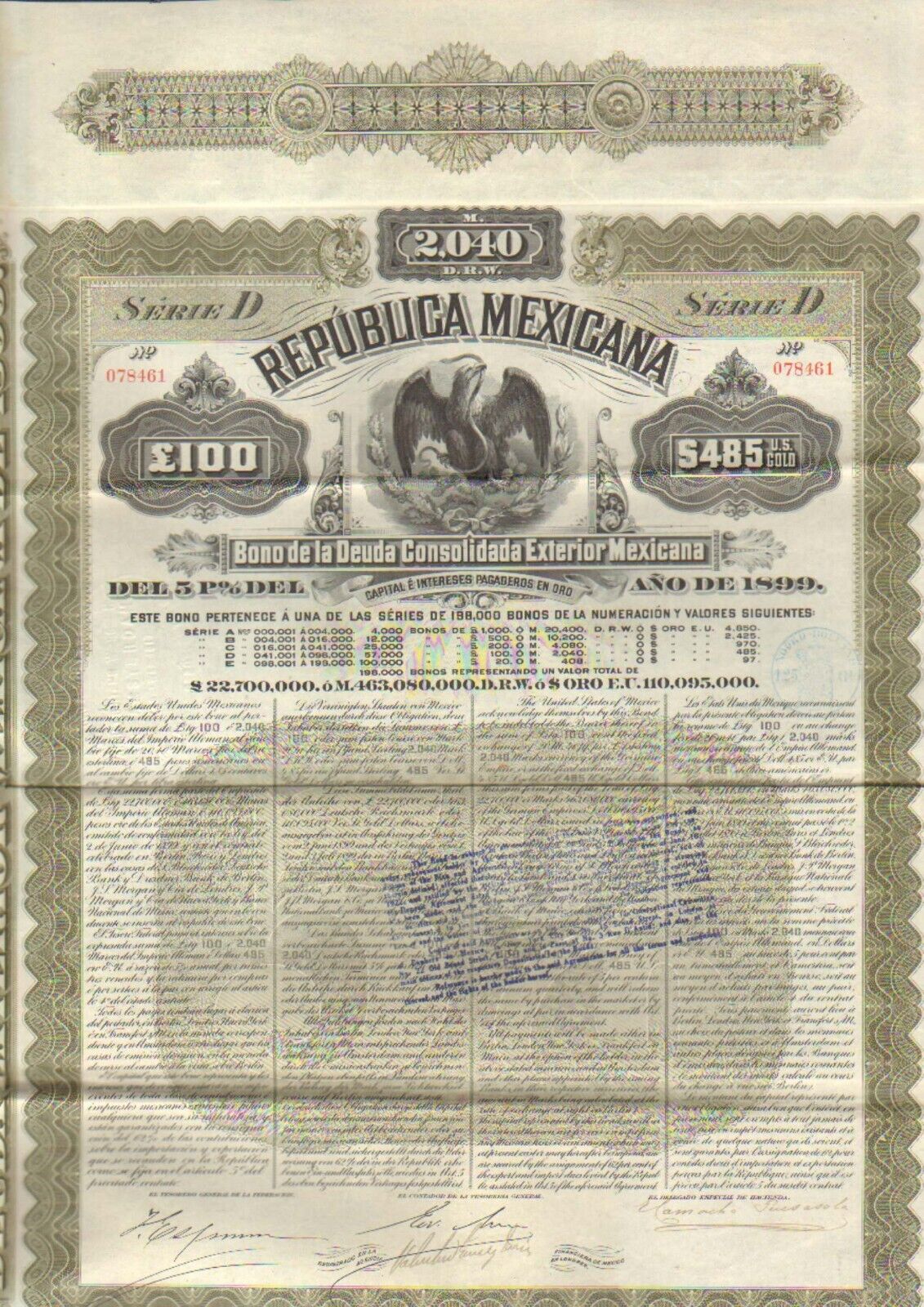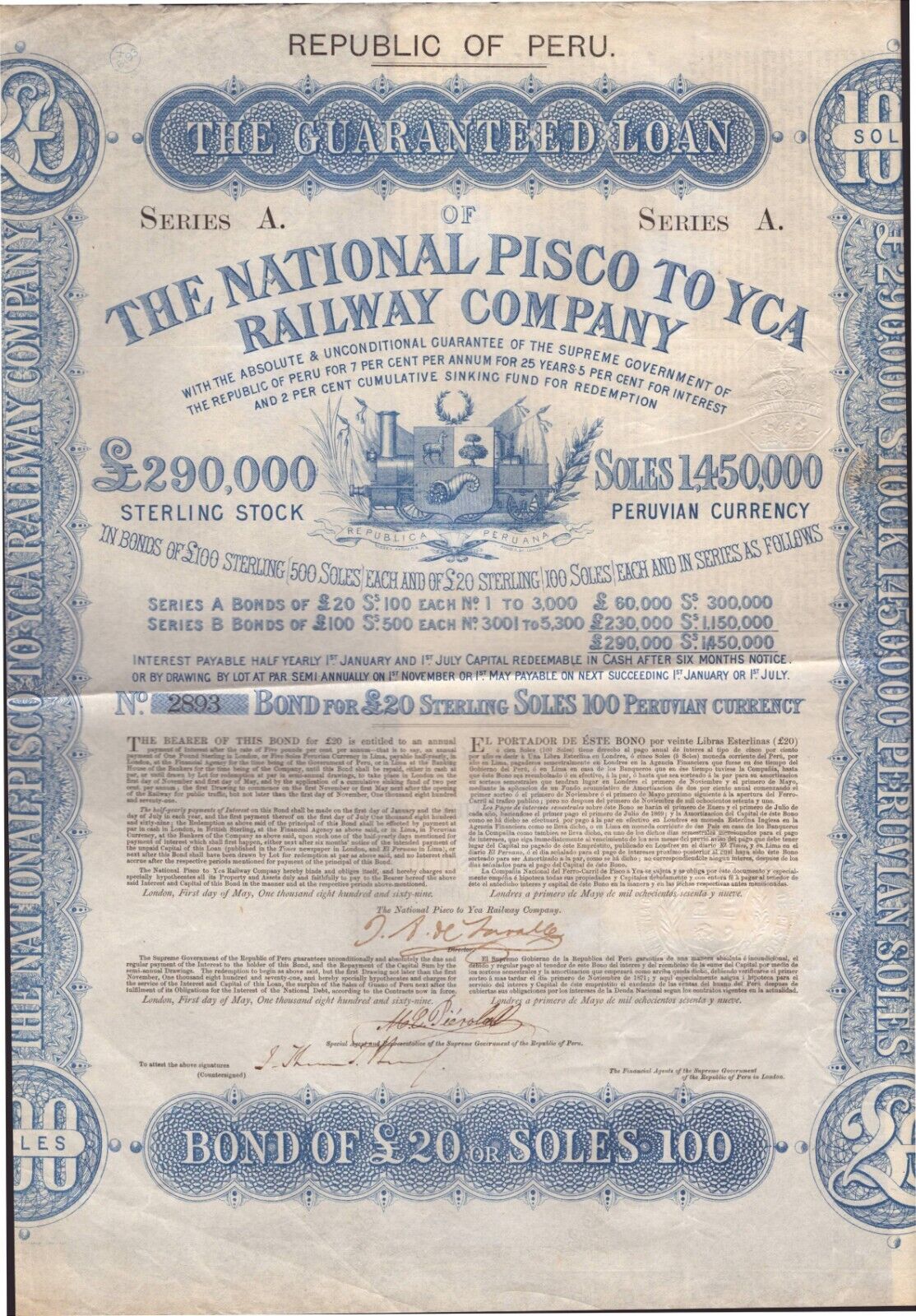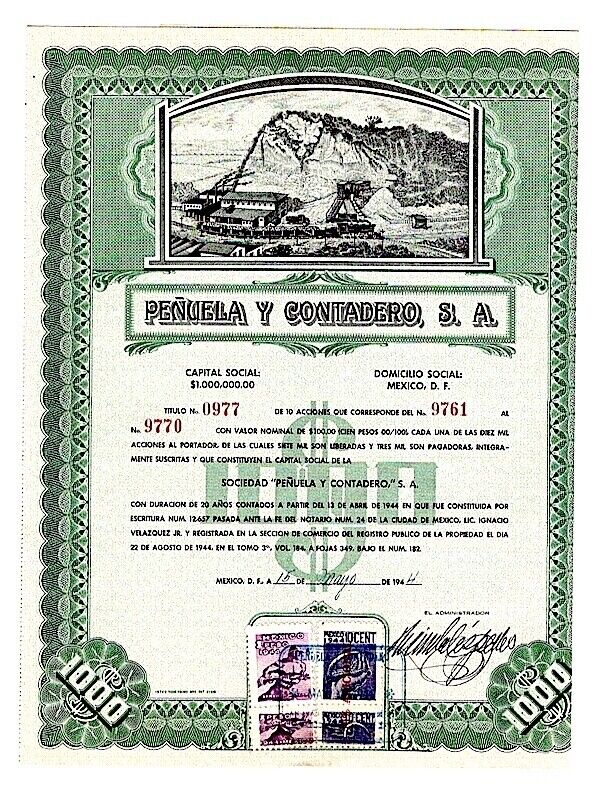-40%
Société d´Exploitations Minières de L´Inini ,Cayenne French Guyana 1948 Share
$ 4.75
- Description
- Size Guide
Description
Notascript Banknotes, Bonds & SharesOne bearer share certificate of the
"
Société d´Exploitations Minières de L´Inini"
,Cayenne ,French Guyana 1948 Share.Condition (opinion) :Very fine+/extremely Fine (VF+/EF). Uncancelled. Size: 27cm/14,5cm (Small .Size of the main document ,without counting the coupons size) .One handwritten signature .Printer :Imprimerie des papiers de valeur .
See below for related information from the web.
Use this picture for reference only, serial number may be different.
---------------------------------------------------------------------------------------
Terms of sale and shippig information
Postage, including packing material, handling fees : Europe: USD 9.00 / USA $ 9.99. Rest of the World: USD 11.15.
FREE of postage for other items.
(excluding
purchases under US.00 with a weight greater than 100 gr. including the protection and packaging card ) .
Only one shipping charge per shipment (the highest one) no matter how many items you buy (combined shipping).
-----------------------------------------------------------------------------
Guaranteed genuine -
One
month
return
policy
(retail sales) .
Returns accepted with no questions.
Customers are invited to combine purchases to save postage.
As we have (or could have) more than one identical item ,the serial number may differ from those shown in the picture which is for reference only.
For purchases above .00 we send the orders registered with tracking number without extra charge, for purchases below .00 we ship as regular letters at the buyer's risk.
For purchases below $ 70,00 who want to register your letter with tracking number, please add an extra for : Europe .20 , U.S. .00 ,Rest of the word .90 .For this case ,please request or wait for our invoice before paying.
Postage include packaging material and handling fees.
For some destinations and purchases below .00 customers may be requested for this extra shipping payment in order to register the shipment with tracking number.
We reserve the right to cancel transactions that require the sending of unregistered letters (without tracking number) to some destinations when this extra payment has been requested.
For purchases over .00, the excess weight will be free.
For purchases under US.00 with a weight greater than 100 gr. including the protection and packaging card, the buyer is asked not to make the payment until receiving the invoice or shipment note, since the cost will be calculated and the type of shipment will be assessed (registered or insured or not) and the buyer will be charged the approximate total of the costs of the Post Office rate (rates that are public and can be consulted), in this case the costs of packaging materials, handling and delivery management are free.
In the event that the buyer has already made the payment, he will be asked to pay the difference that is missing for the payment of the postal rate. Likewise, we reserve the right to cancel transactions that have not been paid this extra amount when requested.
If for any reason, your item did not arrive yet, or you are not 100% satisfied with the item you have received, please do not hesitate to contact , I will do all it takes to provide the best service.
Full refund policy ,including shipping cost, guaranteed in case of lost or theft after the completion of the complaint with Spanish Correos for the registered letters
(free of extra charges for purchases abobe .00 or with the extra charge paid for purchases below .00).
The buyer must notify to us of the delay in the arrival of his purchase when he meets 3 weeks ( to Europe) to 4 weeks (rest of the World) this guarantee expires two months after the shipment of his purchase if we have not previously received notice of the delay
.
-----------------------------------------------------------------------------------
Banknote Grading
UNC
AU
EF
VF
F
VG
G
Fair
Poor
Uncirculated
About Uncirculated
Extremely Fine
Very Fine
Fine
Very Good
Good
Fair
Poor
Edges
no counting marks
light counting folds OR...
light counting folds
corners are not fully rounded
much handling on edges
rounded edges
Folds
no folds
...OR one light fold through center
max. three light folds or one strong crease
several horizontal and vertical folds
many folds and creases
Paper
color
paper is clean with bright colors
paper may have minimal dirt or some color smudging, but still crisp
paper is not excessively dirty, but may have some softness
paper may be dirty, discolored or stained
very dirty, discolored and with some writing
very dirty, discolorated, with writing and some obscured portions
very dirty, discolored, with writing and obscured portions
Tears
no tears
no tears into the border
minor tears in the border, but out of design
tears into the design
Holes
no holes
no center hole, but staple hole usual
center hole and staple hole
Integrity
no pieces missing
no large pieces missing
piece missing
piece missing or tape holding pieces together
<div style="text-align:center"><a style="text-decoration:none" href="http://mostpopular.sellathon.com/?id=AC1061546"><img src="http://www.sellathon.com/Resources/Images/countercredit.gif" border="0"></a></div>
Your browser does not support JavaScript. To view this page, enable JavaScript if it is disabled or upgrade your browser.
See below for related information from the web:
The “Paul Isnard” gold site, of the gold prospector of the same name, includes mining concessions exploited since the 19th century. The discovery of alluvial gold in the Middle Mana region dates back to 1873 with the “Not-Too-Soon” and “Finally! » (discovered by Léonce Melkior in 1875), then with the brothers Ernest and Paul Isnard, the latter having given his name to all the concessions concerned by the project12.
Several mining concessions were established in the area between the end of the 19th century and the beginning of the 20th century12.
In 1940, after around thirty years during which the Guyanese gold industry was abandoned and the placers invaded by marauders, the
"Société d´Exploitations Minières de L´Inini"
Inini Mining Studies and Exploitation Company
(SEEMI)
13,12 was created. She set up a camp at Boeuf-Mort in 1942, carried out surveys at Dékou-Dékou and opened the trail to Paul Isnard12. In 1947 it became the
"Société d´Exploitations Minières de L´Inini"
I (SEMI)
and technical management was entrusted to the Equatorial Mines Company (CEM)12.
In 1949 the CEM and the
SEMI
, with the young Guiana Mining Bureau, whose aim was to promote research and exploitation of subsoil resources in the territory of Guyana, and the Tanon Company, created the “Paul Isnard Syndicate » to resume exploring the area. A modification of mining titles is carried out for the benefit of the Geological and Mining Research Bureau12. Prospecting carried out between 1951 and 1953 estimated a resource of 6 tonnes of alluvial gold and a gallery was dug at the foot of the Dékou-Dékou mountain12. In 1965, the Paul-Isnard Mining Company was created with American capital, which became a sub-owner of BRGM at the end of 196612.
Beyond gold mining, the French botanist Jean-Jacques de Granville cited in 1975 for the first time the Paul-Isnard zone as being of great interest for its natural heritage: “The mining interest of the intermediate zone between the Luc. and Dékou-Dékou massifs are very important14. In December 1995, a state biological reserve of 110,818 ha was created, covering the current integral biological reserve and the intermediate part14.
From 1975 to 1995, for the Ministry of Industry, the Bureau of Geological and Mining Research (BRGM) drew up a mining inventory of all of Guyana15. In 1976, he spotted traces of gold in the soil of the sector for the first time15. At the beginning of the 1980s he refocused on the search for gold mineralization and reported discreet traces of “early hydrothermalism transposed by later tectonics […] suspected in [the sectors of] the Golden Mountain in the region of Paul-Isnard"9 where "sulphide disseminations" and "polymorphic discordant mineralizations"9 suggest potential primary gold veins, the exploitation of which would however require "a strong industrial capacity"9.
In 1986, according to a BRGM report, the CPMI was “in a state of total disrepair and in the last spasms of agony”. After its liquidation, the work will be continued by the Society of Public Works and Gold Mines in Guyana (SOTRAPMAG), created on October 24, 198612. Ownership of the concessions passes from
SEMI
to the Compagnie Générale Équatoriale and, after several changes and absorptions, to the company Alcatel-Alsthom-CGE12.
-----------------------------------------------
Le site aurifère « Paul Isnard », du chercheur d'or du même nom, comprend des concessions minières exploitées depuis le XIXe siècle. La découverte d'or alluvionnaire dans la région de la moyenne Mana date de 1873 avec les placers « Pas-Trop-Tôt » et « Enfin ! » (découvert par Léonce Melkior en 1875), puis avec les frères Ernest et Paul Isnard, ce dernier ayant donné son nom à l'ensemble des concessions concernées par le projet12.
Plusieurs concessions minières sont instituées sur la zone entre la fin du XIXe siècle et le début du XXe siècle12.
En 1940, après une trentaine d'années durant lesquelles l'industrie aurifère guyanaise est délaissée et les placers envahis par les maraudeurs, est créée la Société d'études et d'exploitations minières de l'Inini (SEEMI)13,12. Elle installe un camp à Bœuf-Mort en 1942, réalise des prospections à Dékou-Dékou et ouvre la piste jusqu'à Paul Isnard12. Elle devient en 1947 la
Société d’exploitation minière de l’Inini (SEMI)
et la direction technique est confiée à la Compagnie équatoriale de mines (CEM)12.
En 1949 la CEM et la
SEMI
, avec le jeune Bureau minier guyanais, ayant pour vocation de promouvoir la recherche et l'exploitation des ressources du sous-sol sur le territoire de la Guyane, et la Compagnie Tanon, créent le « Syndicat Paul Isnard » pour reprendre l'exploration du secteur. Une amodiation des titres miniers est réalisée au profit du Bureau de recherches géologiques et minières12. Les prospections réalisées entre 1951 et 1953 évaluaient une ressource de 6 tonnes d'or alluvionnaire et une galerie est creusée au pied de la montagne Dékou-Dékou12. En 1965 est créée la Compagnie minière Paul-Isnard avec des capitaux américains, qui devient sous-amodiataire du BRGM fin 196612.
Au-delà des exploitations aurifères, le botaniste français Jean-Jacques de Granville cite en 1975 pour la première fois la zone de Paul-Isnard comme étant d'un grand intérêt pour son patrimoine naturel : « L'intérêt minier de la zone intermédiaire entre les massifs de Luc. et du Dékou-Dékou sont très importants14. En décembre 1995 est créée une réserve biologique domaniale de 110 818 ha recouvrant l'actuelle réserve biologique intégrale et la partie intermédiaire14.
De 1975 à 1995, pour le Ministère de l’Industrie, le Bureau de recherches géologiques et minières (BRGM) dresse un inventaire minier de toute la Guyane15. En 1976, il repère pour la première fois des traces d'or dans le sol du secteur15. Au début des années 1980 il se recentre sur la recherche de minéralisations en or et fait état de traces discrètes d' « hydrothermalisme précoce transposé par les tectoniques ultérieures […] soupçonnées dans [les secteurs de] la Montagne d'or dans la région de Paul-Isnard »9 où des « disséminations sulfurées » et des « minéralisations discordantes polymorphes »9 évoquant de potentiels filons d'or primaires, dont l'exploitation nécessiterait cependant « une forte capacité industrielle »9.
En 1986, selon un rapport du BRGM la CPMI est « dans un état de délabrement total et dans les derniers spasmes de l’agonie ». Après sa liquidation, les travaux seront poursuivis par la Société de travaux publics et de mines aurifères en Guyane (SOTRAPMAG), créée le 24 octobre 198612. La propriété des concessions passe de la
SEMI
, à la Compagnie générale équatoriale et, après plusieurs évolutions et absorptions, à la société Alcatel-Alsthom-CGE12.











